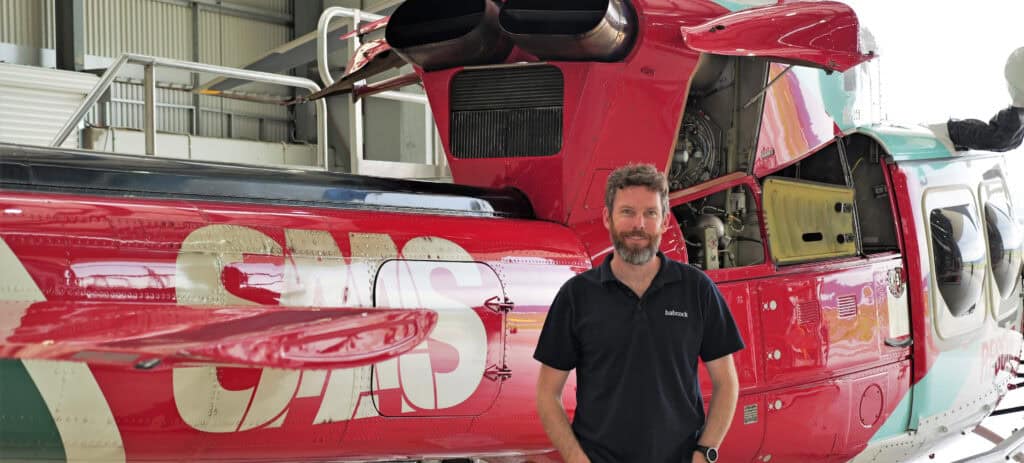
In the far reaches of South Australia’s outback, where the horizon runs unbroken and sudden downpours can turn dirt tracks into rivers, Babcock Senior Base Pilot Iain Whitson has twice answered the same rare call: rescuing a stranded family of four near Oodnadatta.
Four years apart, under strikingly similar circumstances, the Helicopter Emergency Medical Services (HEMS) pilot—serving on Babcock’s South Australian State Rescue Helicopter Service contract—was dispatched to almost identical emergencies.
The first came in November 2021, when a couple and their two young children spent nearly five days trapped in the Simpson Desert after their campervan got stuck in deep mud. More than 1,150 kilometres northwest of Adelaide, they activated an emergency beacon to call for help.
The second was in March this year, when three adults and a child became stranded between Oodnadatta and Finke, near the Northern Territory border. Heavy rain had immobilised their vehicle, and an Australian Maritime Safety Authority (AMSA) Challenger jet had been called in to locate them, dropping food and a satellite phone after they abandoned their car to seek help.
“When the second call came in, there was definitely a sense of déjà vu,” Iain said. “Same area, same weather pattern, same number of people. The difference in location was only about 60 kilometres. I knew the kind of challenges we were heading into but in aviation no two missions are ever truly identical, so we had to plan accordingly.”
Operating at the Edge
Both rescues pushed the limits of range and fuel planning. With refuelling points hundreds of kilometres away, every kilogram of fuel, equipment, and personnel weight had to be calculated.
“You don’t have to go very far north before you are very, very remote,” Iain, 43, said.
“During the first rescue, the distance was too great to return to the usual refuelling stop at Cadney Homestead, so we had to divert to Oodnadatta, where the correct fuel type wasn’t available. We had to improvise, transporting 200-litre drums of diesel from the local roadhouse to the airstrip by ute.”
The second mission was 110 nautical miles from the crews take off point.
“We were right at the limit of our fuel range, leaving us with just 10 minutes on-scene. This made AMSA’s role critical as the family had moved from their initial reported position. Without that update on their location, there wouldn’t have been enough fuel to find and recover them.”
Military Skills in Civilian Rescue
Iain’s 17 years in the Australian Army, flying ARH Tiger attack helicopters, helped hone the skills that proved vital for the operational challenges of the outback—mission planning, navigation, and precision flying in fuel-critical environments.
“In the Army, you are trained to plan for all contingencies,” he said. “That mindset carries over, always balancing mission success with the safety of crews and those you are tasked to rescue.”
Precision Under Pressure
Both rescues required “hot load” landings, where a helicopter is kept running while the aircrew officer and paramedic disembarked to assess and load passengers.
“Given both of the families’ vehicles had become bogged, we knew there was a real risk the ground wouldn’t support the Bell 412’s weight,” Iain said.
Careful visual assessment and selection of higher ground ensured safe touchdowns during both operations.
A Team Effort
Despite successfully performing two near-identical rescues under challenging circumstances, the 2022 Australian Aviation Awards Rotary Pilot of the Year finalist was quick to highlight the collective effort behind the success.
“No rescue is a solo effort,” Iain said. “The airborne crew and I conduct the rescue, but we rely heavily on the support of our Babcock colleagues – engineers who keep the aircraft ready and operations staff who coordinate the missions. And, of course, partner agencies like AMSA, SAPOL, SA Ambulance Service, and local responders such as the Cadney Homestead team. Together, we make it possible.”
For Iain, the true reward is not recognition but results.
“You don’t fly into the outback for accolades—you fly in because someone needs help. The best outcome is always leaving knowing you made a difference.”
Watch the below footage of the rescue, courtesy of the Australian Maritime Safety Authority.
